
Crates Accepted by the Airlines
Selecting the correct size crate is crucial for ensuring that your pet is accepted by the airline and travels comfortably. An appropriately sized crate will not only meet the airline’s requirements but also provide your pet with enough space to stand, turn around, and lie down during the flight. This is essential for your pet’s safety and well-being throughout the journey. It is important to remember that each airline has specific size requirements, so selecting the right crate that aligns with those guidelines is key to a smooth travel experience. To determine the proper crate size for your pet, it’s essential to measure your pet correctly. Please refer to the “Measuring Your Pet” tab for more detailed information on how to properly measure your pet and select the ideal crate size. Ensuring the correct fit can make a significant difference in your pet’s comfort, and it will increase the chances of a successful and stress-free flight.
Standard Airline Crate Sizes
The following are the typical standard crate sizes used by airlines for pet travel. Please note that sizes may slightly vary by manufacturer, so it is important to confirm with the airline directly. Ensuring your pet’s crate fits the airline’s guidelines is crucial for a smooth travel experience.
•Small (100 series): 24” x 16” x 15”
Ideal for small dogs and cats, typically weighing up to 15 lbs. This size allows enough space for your pet to comfortably stand, sit, and lie down during the journey.
•Medium (200 series): 28” x 20.5” x 21.5”
Suitable for medium-sized pets, such as small to medium dogs or larger cats, weighing between 15-25 lbs. It offers enough room for your pet to move around a bit more while still being compact enough to meet airline restrictions.
•Intermediate (300 series): 32” x 22” x 23”
Designed for medium-sized dogs or multiple cats, weighing between 25-40 lbs. This crate offers ample space for your pet to stand and turn around with comfort while ensuring that they are safely secured for travel.
•Large (400 series): 36” x 25” x 27”
Perfect for large dogs or multiple smaller pets, weighing between 40-70 lbs. This size allows your pet to stretch out and be more comfortable during long flights, providing them with enough space for movement.
•Extra Large (500 series): 40” x 27” x 30”
For extra-large pets or larger breeds weighing between 70-100 lbs. This crate provides a spacious environment for your pet to stand and move around comfortably during the journey.
•Giant (700 series): 48” x 32” x 35”
Typically used for giant breeds or very large dogs, weighing over 100 lbs. This crate provides ample space for even the largest pets, ensuring they are safe, secure, and comfortable during transit.
Crate Types Accepted by Airlines
Airlines typically have strict requirements for the types of crates they accept for pet travel. The following are the main crate types that meet airline regulations:
•Hard Plastic Crates:
These are the most commonly accepted crate type for pet transport. They are durable and provide a secure, enclosed space for pets during travel.
•Ventilation Holes: Ensure that the crate has ventilation holes on all four sides to provide proper airflow and prevent your pet from feeling too confined. This is essential for long-distance travel.
•Metal Nuts and Bolts: The crate must have metal hardware to secure the top and bottom together. This helps prevent accidental openings during transit and ensures your pet’s safety. Plastic latches or clips are not acceptable as they may break or loosen.
•Custom Crates: Custom crates may be allowed, but they must meet specific IATA (International Air Transport Association) guidelines, which vary depending on the species being transported. These crates must be robust enough to withstand the rigors of air travel and secure enough to keep the pet safe inside.
Each airline has its regulations regarding crate sizes and materials, so it’s important to confirm with your airline before booking your pet’s flight. By following these guidelines, you can ensure that your pet is comfortable, secure, and meets the airline’s standards for safe travel.
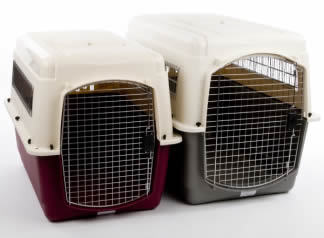
- Crates with wheels
- Fabric or soft-sided crate (unless traveling in cabin – pictured on right)
- Crates with dial latches to hold the top and bottom together (picture 1 below)
- Wire crates (picture 2 below)
- Top opening crates (picture 3 below)
- Crates with side snaps to hold the top and bottom together (picture 4 below)
- Collapsible crates (similar to picture 2 below but may be made of plastic)
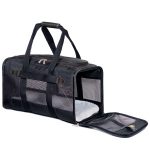
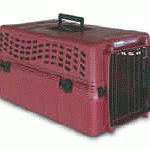
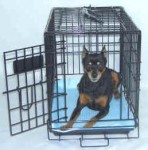

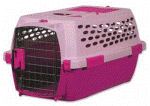
Helping Your Pet Feel Secure in the Crate
To ensure your pet feels comfortable and secure during its journey, it’s important to purchase the shipping kennel well in advance—ideally several weeks before your pet’s trip. This gives your pet enough time to adjust to the crate and reduces the stress of travel. Acclimating your pet to the crate gradually can help them feel more at ease with their new environment. Our team can provide you with valuable tips on crate training, which can greatly ease your pet’s anxiety and enhance their travel experience.
Additionally, including a personal item, such as a piece of clothing from a family member, can help comfort your pet during travel. The scent of a familiar person can provide reassurance and make the journey feel less stressful. It’s best to use an item that has been worn but not washed, as the scent will be more recognizable to your pet.
Items Prohibited in the Crate
When packing your pet’s crate, it’s important to follow the airline guidelines regarding what is and isn’t allowed inside. Some items are strictly prohibited for safety and comfort reasons. Here is a list of items that should not be placed inside your pet’s crate:
•High-sided beds: These may limit your pet’s space and could cause discomfort during the trip.
•Toys & Kongs: Most toys are not permitted in the crate, but solid chew items like Nylabones are acceptable for pets that need something to chew on during the flight.
•Cat litter: For feline travel, only specific types of bedding are allowed, and traditional cat litter may not be suitable.
•Shavings for rodent-type shipments: Certain types of bedding, like wood shavings, are not allowed for small animal transport.
•Medicines: If your pet requires medication during transit, all medicines must be placed in a prescription bottle and stored in a zip-lock bag. This bag should then be taped securely to the top of the crate. Be sure to include clear dosage instructions for any medications that may need to be administered while your pet is traveling.
By adhering to these guidelines and preparing your pet ahead of time, you can help make their travel experience smoother and less stressful.

